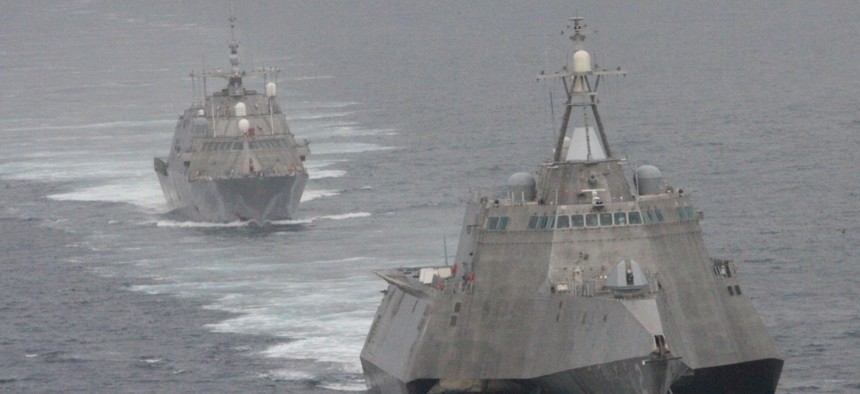
The first of class littoral combat ships USS Freedom and USS Independence maneuver together during an exercise off the coast of Southern California in May 2012. U.S. Navy photo by Lt. Jan Shultis
Navy Finds 32 Problems with Littoral Combat Ships
Study reveals “key reliability issues” and maintenance averaging up to two weeks per month to fix.
The Navy has identified almost three dozen upgrades and fixes that are needed for the littoral combat ships to improve their reliability, and has selected a commander to oversee the ship’s improvement efforts.
“We found…there were about 32 key reliability issues across both variants that were impacting our ability to get underway and meet those fleet commander requirements,” Vice Adm. Roy Kitchener, the commander of Naval Surface Forces, told reporters Monday.
Last year, Kitchener launched a “study” of maintenance and reliability problems that cut into deployments. It follows a 2016 review that established better LCS training and manning methods..
The LCS study actually consists of internal working documents containing data collected on deployments and other significant events, according to Cmdr. Nicole Schwegman, a Naval Surface Forces spokeswoman.
The study addresses problems along four lines of effort: reliability, sustainability, lethality, and force generation. The study’s data and conclusions guide efforts to improve the ships by Task Force LCS, led by Rear Adm. Robert Nowakowski, the deputy commander of both Navy Recruiting Command and Naval Education and Training Command Force Development.
A “strike team” within Program Executive Office Unmanned and Small Combatants was already focusing on the ship’s reliability problems and identified 32 needed fixes and upgrades. Members of this team are now part of Task Force LCS.
Kitchener asked the PEO USC to determine which of the 32 fixes would have “the biggest impact with the biggest return on investment” and they came up with nine: five for the Freedom-class LCS and four for the Independence-Class LCS.
Kitchener said the long list of upgrades for the ships is in part due to ship features that the Navy was not used to operating, such as the water jets for propulsion, and discovering problems that arose while the ships got underway.
Nowakowski added that because there are two types of LCS with different parts and pieces, the number of upgrades and fixes is higher than if it was just one type of ship.
The problems with the Freedom variant are with the combining gear, diesel generator rigid mounts, fuel lines, a water jet upgrade, and boat davit upgrades. The combining gear, which connects the ship’s two engines, had already been determined to be a class-wide defect following propulsion failures with multiple ships. The Navy has just finished its onshore testing of an improved combining gear, which is being installed in the future USS Minneapolis-St. Paul and will undergo more testing, Kitchener said.
The Independence-class needs water cylinder replacements, pressure switch replacements, diesel engine replacements, and water jackets on the diesel engines.
Kitchener said the goal is to improve the reliability of both LCS variants and see in 2022 how much more use the Navy is getting out of the deployed ships.
Sustaining its warships is the task force’s second priority, after ensuring reliability.
The ships require preventative maintenance by contractors about once a month for about one to two weeks. And if repairs are needed while deployed, it can take a contractor about 21 days to get there and complete the work, according to Kitchener. The Navy is working to reduce repairs to just five days and is looking at whether they can reduce the frequency of preventative maintenance to every two months.




